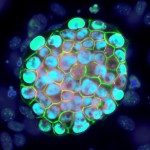Link to Pubmed [PMID] – 28649443
Npj Systems Biology and Applications, 3(1), 16.
Embryonic development is a self-organised process during which cells divide, interact, change fate according to a complex gene regulatory network and organise themselves in a three-dimensional space. Here, we model this complex dynamic phenomenon in the context of the acquisition of epiblast and primitive endoderm identities within the inner cell mass of the preimplantation embryo in the mouse. The multiscale model describes cell division and interactions between cells, as well as biochemical reactions inside each individual cell and in the extracellular matrix. The computational results first confirm that the previously proposed mechanism by which extra-cellular signalling allows cells to select the appropriate fate in a tristable regulatory network is robust when considering a realistic framework involving cell division and three-dimensional interactions. The simulations recapitulate a variety of in vivo observations on wild-type and mutant embryos and suggest that the gene regulatory network confers differential plasticity to the different cell fates. A detailed analysis of the specification process emphasizes that developmental transitions and the salt-and-pepper patterning of epiblast and primitive endoderm cells from a homogenous population of inner cell mass cells arise from the interplay between the internal gene regulatory network and extracellular signalling by Fgf4. Importantly, noise is necessary to create some initial heterogeneity in the specification process. The simulations suggest that initial cell-to-cell differences originating from slight inhomogeneities in extracellular Fgf4 signalling, in possible combination with slightly different concentrations of the key transcription factors between daughter cells, are able to break the original symmetry and are amplified in a flexible and self-regulated manner until the blastocyst stage. The early development of the mammalian embryo involves cell divisions and highly regulated lineage specification events. Cell fates are determined by gene regulatory networks exhibiting multiple steady states. The question arises as to how these networks interact with extracellular signalling, cell division and cell movement. Here, we investigate this question in the context of establishment of the salt-and-pepper pattern of epiblast (Epi) and primitive endoderm (PrE) cells within the inner cell mass (ICM) of the preimplantation embryo in the mouse, using a multi-scale computational model. The three cell fates correspond to three stable steady states of the gene regulatory network, which coexist in the salt-and-pepper pattern. The specification process is self-regulated through extracellular signalling and is robust towards cell division and cell movement.


